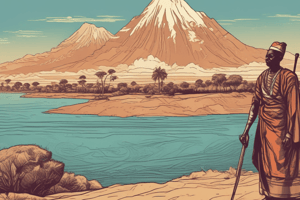Podcast
Questions and Answers
What was the result of the British government's takeover of India in 1858?
What was the result of the British government's takeover of India in 1858?
How did the East India Company initially establish its power in India?
How did the East India Company initially establish its power in India?
Which of the following best describes the nature of colonization experienced in India compared to other regions?
Which of the following best describes the nature of colonization experienced in India compared to other regions?
What key event marked the beginning of the East India Company's direct control over significant parts of India?
What key event marked the beginning of the East India Company's direct control over significant parts of India?
Signup and view all the answers
What was primarily exploited by the East India Company during its rule in India?
What was primarily exploited by the East India Company during its rule in India?
Signup and view all the answers
What was the primary goal of King Leopold II in the Congo Free State?
What was the primary goal of King Leopold II in the Congo Free State?
Signup and view all the answers
Which explorer worked for King Leopold II, traveling extensively across the Congo?
Which explorer worked for King Leopold II, traveling extensively across the Congo?
Signup and view all the answers
What was the title given to the region controlled by King Leopold II in 1885?
What was the title given to the region controlled by King Leopold II in 1885?
Signup and view all the answers
What was a significant characteristic of the colonization process in the Congo?
What was a significant characteristic of the colonization process in the Congo?
Signup and view all the answers
Which year marked the beginning of Stanley's significant expansion in the Congo?
Which year marked the beginning of Stanley's significant expansion in the Congo?
Signup and view all the answers
What was the nature of the relationship between Stanley and Leopold II?
What was the nature of the relationship between Stanley and Leopold II?
Signup and view all the answers
Which trading outpost did Stanley establish that played a crucial role in the Congo?
Which trading outpost did Stanley establish that played a crucial role in the Congo?
Signup and view all the answers
What was a common misrepresentation made by Leopold regarding his activities in the Congo?
What was a common misrepresentation made by Leopold regarding his activities in the Congo?
Signup and view all the answers
Study Notes
Colonialism in Africa - The Congo
- The European presence in Africa was limited to coastal regions for centuries.
- The Congo was largely unknown until Henry Stanley's expedition in 1871 in search of Dr David Livingstone.
- Stanley's travels and subsequent research led him to work for King Leopold II of Belgium in 1879.
- King Leopold II's objective was to acquire as much land as possible in the Congo, using any means necessary.
- Leopold personally funded Stanley and his expeditions, as well as the soldiers, administrators, and workers sent from Europe.
- From 1881, Stanley established a foothold in the Congo, expanding the territory to the East and South.
- In 1885, Leopold’s territory became known as the Congo Free State, and Leopold was its absolute monarch.
- The Congo Free State was governed by an Administrator-General responsible for overseeing rubber production, which was extremely profitable.
- Despite committing atrocities, Leopold portrayed the Congo Free State as a philanthropic and humanitarian mission.
- Critics denounced Leopold's actions as early as 1890, but it wasn't until 1908 that the Belgian government annexed the Congo Free State as a colony, ending the atrocities.
Colonialism in India
- India experienced both settler and exploitative colonialism.
- Although the number of Europeans in India was relatively low, relationships between Europeans and natives were often characterized by a sense of equality.
- Some cases of resource and people exploitation occurred, particularly under the East India Company (EIC)'s rule.
- The EIC's management of opium production and exportation is a prime example of exploitation.
- The EIC initially maintained a trading relationship with Indian rulers.
- Following the Battle of Plassey in 1757, the EIC installed Mir Jafar as the ruler of India, subservient to the Company.
- The EIC expanded its territorial possessions throughout the late 18th and early 19th centuries.
- By the mid-19th century, the EIC directly or indirectly controlled the entire Indian subcontinent.
- After the Indian Mutiny of 1857, the British government assumed control of India, replacing the EIC and establishing a viceroy or governor general to manage day-to-day affairs.
- This period is known as the British Raj.
Studying That Suits You
Use AI to generate personalized quizzes and flashcards to suit your learning preferences.
Related Documents
Description
Explore the complexities of colonialism in the Congo, focusing on Henry Stanley's expeditions and King Leopold II's ambitions. Learn about the establishment of the Congo Free State and the exploitation of its resources. This quiz delves into the historical context and impacts of European colonization in Africa.




